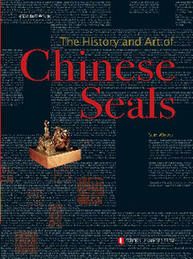Artistic Impression
Artistic Impression

The History and Art of Chinese Seals
By Sun Weizu
573 pages
RMB 420
Published in Beijing by Foreign Languages Press
FOR the average non-Chinese the appreciation of more obviously accessible forms of Chinese art – shanshui landscapes, present no great problem and even calligraphy can be approached purely as abstract art. But a “chop?” As a modestly-priced souvenir, bearing a laser-carved approximation of one’s name, perhaps. But as an art form that changes hands at fantastic prices? That takes some explaining.
This book sets out to do just that. And it would be hard to find a guide more qualified to do so than its author Sun Weizu, research fellow of the Shanghai Museum. Nor would it be easy to find a more sumptuous and alluring presentation of the subject: the publisher has pulled out all the stops to do justice to this scholarly exposition, with over 1,400 pictures and engraving impressions, beautifully reproduced on fine quality stock that makes the finished product a pleasure simply to page through.
But it deserves better than coffee-table treatment: it is a work of exacting scholarship tracking 2,500 years of seal use in China. The author plots their development from basic impressions on clay-sealed containers, through awesome symbols of imperial authority, insignia of government office, personal identity, stamp of ownership, and ultimately to artistic genre at the hands of scholar engravers. As the functions, aesthetics, and social significance of seals and seal engraving are explored, the reader is taken on a journey through Chinese history, political, social and cultural institutions. Those seemingly abstract cinnabar-paste impressions have much to tell us.
Though other civilizations may have used seals somewhat earlier than in China, their long-established importance is underlined by the presence of the word “seal” in China’s first dictionary, compiled around the second century, where it is defined as “what an official holds for authentication in government affairs” and “a means of identification.” Where other ancient seal-using civilizations faded away, China’s continued on its path, and the systems, layout, inscription content, scripts, and aesthetics of seals went on developing, being exported to neighbours and adopted by minority peoples and regimes. Rigid rules, based on rank, initially governed the hierarchy of material (e.g. jade, silver), knob form (e.g. tiger, turtle, nose) and content of official seals. But even as the seal’s connections with officialdom loosened and practical applications went into decline, the aesthetic dimension became more pronounced, leading to the rise in the Ming Dynasty of scholar seal engraving, or zhuanke, a uniquely Chinese art form which produced stellar exponents whose works went for very handsome prices and around whom schools of seal engraving and specialist institutions formed. Inevitably, the authority inherent in imperial and official seals, and the aesthetic and economic value of zhuanke masterpieces were incentives to fakery, so connoisseurs and collectors will appreciate the expert guidance on how to appraise seals and spot an impostor. Personal seals were invariably imprinted onto works of art by their owners as appreciation, embellishment and stamp of ownership, becoming an integral part of the work itself. It follows, then, that works of art created a market for fake seals, expanding the scope for skullduggery.
The author traces the evolution of different engraving techniques, types of script used and the relationship with calligraphic fashion. Seal scripts being noted more for their beauty than their legibility to non-specialists, readers will also appreciate the painstaking editing, which provides the modern Chinese characters for the inscriptions alongside the English translation of the content. The author’s observations are referenced with pictorial examples from public and private collections across China and beyond.
This rich compendium of seal history is described by James C. Wyatt of the Metropolitan Museum of Art in New York as “required reading for all students of Chinese art” and a “great source of inspiration” for those interested in graphic design.
Services
Economy
- Eco-agriculture and Eco-tourism Power Nanchang’s Green Development
- Balance Environmental Protection and Economic Prosperity – Nanchang Looks to European Technology for Green Development
- Sustainable Growth Requires Wiser Energy Use
- Chinese Economy: On the Path of Scientific Development
- China's Economy over the Last Ten Years

